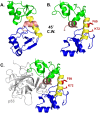E6 proteins from high-risk HPV, low-risk HPV, and animal papillomaviruses activate the Wnt/β-catenin pathway through E6AP-dependent degradation of NHERF1
- PMID: 31002735
- PMCID: PMC6493770
- DOI: 10.1371/journal.ppat.1007575
E6 proteins from high-risk HPV, low-risk HPV, and animal papillomaviruses activate the Wnt/β-catenin pathway through E6AP-dependent degradation of NHERF1
Abstract
High-risk human papillomavirus (HPV) E6 proteins associate with the cellular ubiquitin ligase E6-Associated Protein (E6AP), and then recruit both p53 and certain cellular PDZ proteins for ubiquitination and degradation by the proteasome. Low-risk HPV E6 proteins also associate with E6AP, yet fail to recruit p53 or PDZ proteins; their E6AP-dependent targets have so far been uncharacterized. We found a cellular PDZ protein called Na+/H+ Exchanger Regulatory Factor 1 (NHERF1) is targeted for degradation by both high and low-risk HPV E6 proteins as well as E6 proteins from diverse non-primate mammalian species. NHERF1 was degraded by E6 in a manner dependent upon E6AP ubiquitin ligase activity but independent of PDZ interactions. A novel structural domain of E6, independent of the p53 recognition domain, was necessary to associate with and degrade NHERF1, and the NHERF1 EB domain was required for E6-mediated degradation. Degradation of NHERF1 by E6 activated canonical Wnt/β-catenin signaling, a key pathway that regulates cell growth and proliferation. Expression levels of NHERF1 increased with increasing cell confluency. This is the first study in which a cellular protein has been identified that is targeted for degradation by both high and low-risk HPV E6 as well as E6 proteins from diverse animal papillomaviruses. This suggests that NHERF1 plays a role in regulating squamous epithelial growth and further suggests that the interaction of E6 proteins with NHERF1 could be a common therapeutic target for multiple papillomavirus types.
Conflict of interest statement
The authors have declared that no competing interests exist.
Figures










Similar articles
-
Multiple regions of E6AP (UBE3A) contribute to interaction with papillomavirus E6 proteins and the activation of ubiquitin ligase activity.PLoS Pathog. 2020 Jan 23;16(1):e1008295. doi: 10.1371/journal.ppat.1008295. eCollection 2020 Jan. PLoS Pathog. 2020. PMID: 31971989 Free PMC article.
-
PDZ Domain-Containing Protein NHERF-2 Is a Novel Target of Human Papillomavirus 16 (HPV-16) and HPV-18.J Virol. 2019 Dec 12;94(1):e00663-19. doi: 10.1128/JVI.00663-19. Print 2019 Dec 12. J Virol. 2019. PMID: 31597772 Free PMC article.
-
HPV16 E6 promotes cervical cancer cell migration and invasion by downregulation of NHERF1.Int J Cancer. 2019 Apr 1;144(7):1619-1632. doi: 10.1002/ijc.31876. Epub 2018 Dec 13. Int J Cancer. 2019. PMID: 30230542
-
Warts, cancer and ubiquitylation: lessons from the papillomaviruses.Trans Am Clin Climatol Assoc. 2006;117:113-26; discussion 126-7. Trans Am Clin Climatol Assoc. 2006. PMID: 18528468 Free PMC article. Review.
-
The role of TP53 in Cervical carcinogenesis.Hum Mutat. 2003 Mar;21(3):307-12. doi: 10.1002/humu.10178. Hum Mutat. 2003. PMID: 12619117 Review.
Cited by
-
High-Risk HPV Oncoproteins and PD-1/PD-L1 Interplay in Human Cervical Cancer: Recent Evidence and Future Directions.Front Oncol. 2020 Jun 30;10:914. doi: 10.3389/fonc.2020.00914. eCollection 2020. Front Oncol. 2020. PMID: 32695664 Free PMC article. Review.
-
LncRNA WWTR1-AS1 upregulates Notch3 through miR-136 to increase cancer cell stemness in cervical squamous cell carcinoma.BMC Womens Health. 2024 Feb 8;24(1):104. doi: 10.1186/s12905-024-02905-7. BMC Womens Health. 2024. PMID: 38331752 Free PMC article.
-
LncRNA LUADT1 Promotes Oral Squamous Cell Carcinoma Cell Proliferation by Regulating miR-34a/GAS1 Axis.Cancer Manag Res. 2020 May 13;12:3401-3407. doi: 10.2147/CMAR.S238830. eCollection 2020. Cancer Manag Res. 2020. PMID: 32494204 Free PMC article.
-
Molecular aspects of cervical cancer: a pathogenesis update.Front Oncol. 2024 Mar 19;14:1356581. doi: 10.3389/fonc.2024.1356581. eCollection 2024. Front Oncol. 2024. PMID: 38567159 Free PMC article. Review.
-
E6AP is essential for the proliferation of HPV-positive cancer cells by preventing senescence.PLoS Pathog. 2025 Feb 7;21(2):e1012914. doi: 10.1371/journal.ppat.1012914. eCollection 2025 Feb. PLoS Pathog. 2025. PMID: 39919145 Free PMC article.
References
-
- Rector A, Van Ranst M. Animal papillomaviruses. J Virol. 2013;445(1):213–23. - PubMed
Publication types
MeSH terms
Substances
Grants and funding
LinkOut - more resources
Full Text Sources
Research Materials
Miscellaneous

